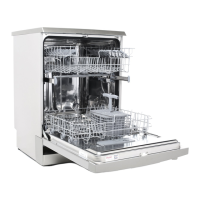What does error E3 mean on a Haier Dishwasher?
- LLawrence MaloneSep 5, 2025
If your Haier Dishwasher displays the error "E3", it indicates that the drain hose is too low. Check the height of the drain hose.

What does error E3 mean on a Haier Dishwasher?
If your Haier Dishwasher displays the error "E3", it indicates that the drain hose is too low. Check the height of the drain hose.
Why is there detergent stuck in the dispenser of my Haier HDW12-TFE3SS Dishwasher?
If there are remnants of detergent stuck inside the dispenser of your Haier Dishwasher, it's likely because the compartment was damp when it was filled. Ensure the compartment is dry before adding detergent.
Why are tea stains still on my cups after using the Haier HDW12-TFE3SS?
If tea stains or traces of lipstick are not completely removed after washing in your Haier Dishwasher, the detergent may not have a sufficient bleaching effect, or the washing temperature was set too low. Use a detergent with a better bleaching effect or increase the washing temperature.
Why is there too much foam in my Haier HDW12-TFE3SS Dishwasher?
If an unusual amount of foam is created in your Haier Dishwasher, it's likely that normal washing up liquid has been poured into the rinse-aid container. Remove any spilled rinse aid.
Why is my Haier HDW12-TFE3SS Dishwasher making a knocking sound?
If you hear a knocking sound while your Haier Dishwasher is running, a spray arm is likely hitting the dishes inside. Rearrange the dishes to prevent the knocking.
| Type | Freestanding |
|---|---|
| Capacity | 12 Place Settings |
| Energy Rating | E |
| Wash Programs | 6 |
| Child Lock | Yes |
| Energy consumption per 100 cycles | 92 kWh |
| Quick wash cycle | Yes |
| Colour | Stainless Steel |
| Delay Start | Yes |
| Noise Level | 47 dB |
Describes waste connection to a standpipe.
Describes waste connection to a sink trap.
Details connection requirements, cold water preference, and temperature limits.
Specifies minimum and maximum water pressure and actions for deviations.
Emphasizes earthing, cord replacement, and accessibility of outlet.
Key checks for installers before finalising.
Identifies buttons, lights, and indicators on the control panel.
Labels and describes parts inside the dishwasher.
Explains the purpose and indicator for rinse aid.
Details how to fill the dispenser and adjust dosage.
Specifies detergent type and dispenser location.
Instructions for filling main and pre-wash compartments.
Discusses causes and remedies for glassware damage.
Guidance on loading the lower rack and silverware basket.
Details placement on the upper rack, shelf, and knife rack.
How to choose programmes and factors affecting data.
Steps to turn on the appliance and select a programme.
Steps to turn off the appliance after a cycle.
How to stop a running cycle and safety precautions.
Instructions for setting a delayed start time.
How to change or cancel a running cycle.
How to use the half load option for smaller loads.
How to use the reset drain function.
Daily care steps after each wash.
Advice on unplugging, cleaning, moving, and holiday care.
Checking for grease, scale, and cleaning the interior.
Instructions for cleaning the coarse micro-filter and filter unit.
Guidance on resolving common issues without a service engineer.
Lists common causes when the appliance fails to start.
Addresses food remnants on dishes due to loading or blockages.
Guidelines for environmentally friendly disposal of old appliances.
Information on comparability tests according to AS/NZS 2007.